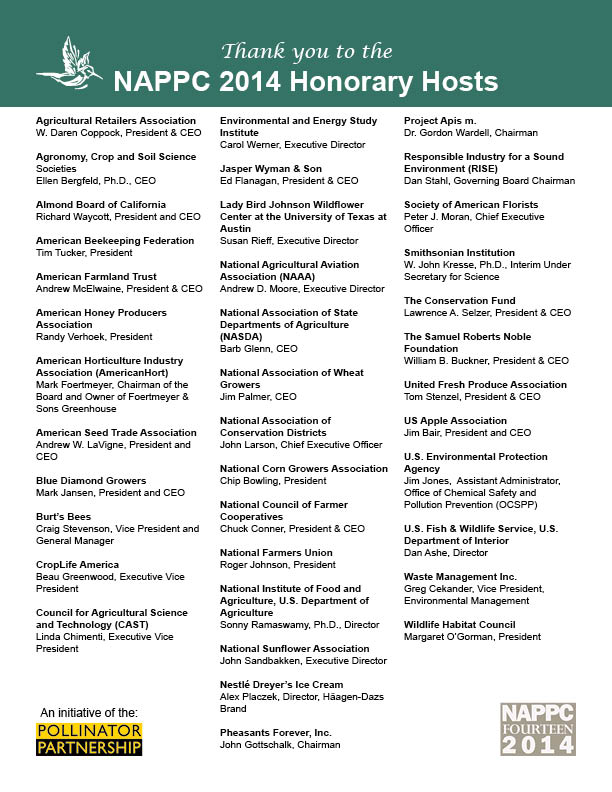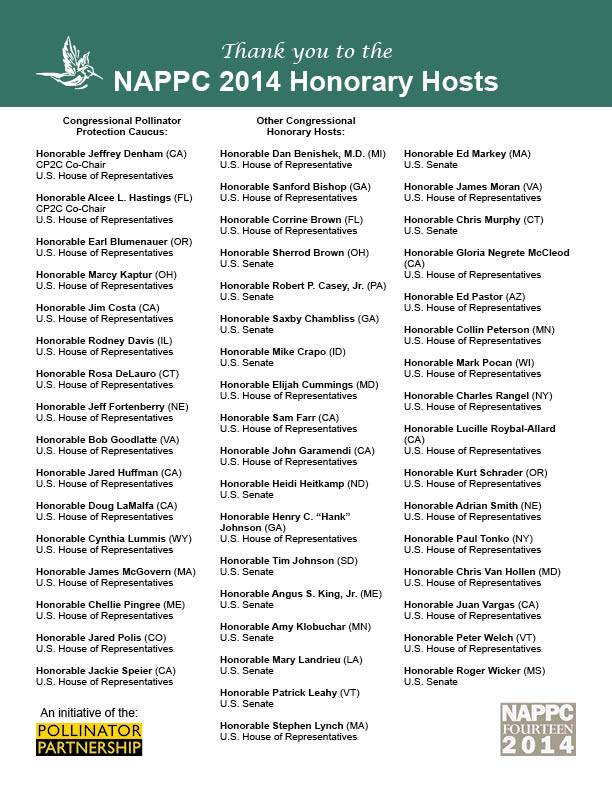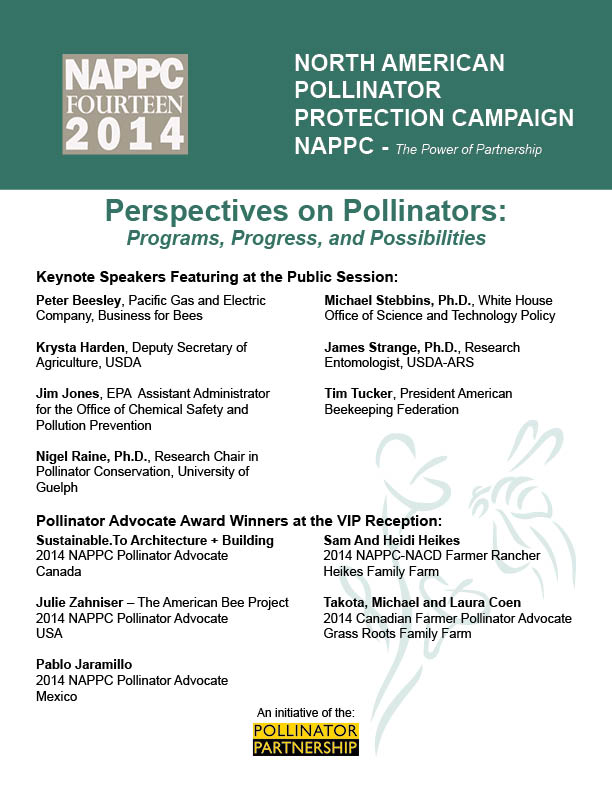 |
14th ANNUAL NAPPC INTERNATIONAL CONFERENCE |
|
Actions to stem pollinator declines were the focus of the 14th Annual North American Pollinator Protection Campaign (NAPPC) International Conference in Washington, DC on October 21-23. Participants were informed and inspired by leading Administration officials and key stakeholders.
The Administration was represented by Michael Stebbins, Ph.D., White House Office of Science and Technology Policy; Krysta Harden, Deputy Secretary of Agriculture; Jim Jones, EPA Assistant Administrator of the Office of Chemical Safety and Pollution Prevention; and Butch Blazer, USDA Deputy Under Secretary for Natural Resources and Environment. Stebbins is a lead architect of the Presidential Memorandum (PM) on Pollinator Health signed by President Obama during 2014 National Pollinator Week, and Harden co-chairs the interagency task force charged with implementing the PM.
Stebbins expressed appreciation for the Pollinator Partnership's input during the development of the PM and indicated that the interagency task force report is on schedule to be completed by the December 20 goal, but would likely not be released until sometime in the spring to be more timely. Harden reported that the task force members in USDA and across the other agencies are meeting frequently and working hard to develop actions that will move the needle on the health of honey bees and other pollinators. Both Stebbins and Harden emphasized the importance of public-private partnership efforts.
Peter Beasley, Pacific Gas and Electric (PG&E), spoke about P2's Business for Bees initiative launched in response to the PM, and provided highlights of PG&E's pollinator actions. Tim Tucker, American Beekeeping Federation President, spoke to the challenges faced by the nation's beekeepers and their honey bees.
150 leading scientists, stakeholder representatives and agency representatives in NAPPC then developed voluntary initiatives for the coming year that help address critical pollinator issues in agriculture, pesticide misuse, resource competition, and outreach to the public, and to respond to the PM.
2014 Pollinator Farmer-Rancher Award Winners
|
|
Heikes Family Farm (Vermillion, SD) picks-up national sward for CSA and farm management that helps to feed the bees. The NAPPC-NACD Farmer-Rancher Pollinator Award recognizes individuals who have contributed significantly to pollinator protection, conservation, and issue outreach resulting in increased awareness of the importance of pollinators and pollination within the agricultural community. This special award sheds light on the contributions of American farmers to natural and cultural resource preservation. Sam Heikes and his daughter Heidi have been farming land that has been in their family since the 1900’s with a suitable model that puts the science of crop manage first. Sam Heikes has always worked with techniques that were developed through science and understanding of ecosystem functions and the way in which economics can make or break diversified farming systems. Sam’s motivation to support sustainable agriculture in the plains all started with sunflowers. Trained as an agronomist, Sam knew how to design cropping systems that were resilient to pests, produced high yields, and provided other ecological benefits. Within the wheat fields of South Dakota, efforts to improve crop yields and reduce pest infestations were being hampered by government programs that imposed production limits and crop restrictions. Sunflowers benefit wheat in many ways, and planting sunflowers after a wheat harvest would provide soil benefits and food to beneficial species like bees. Sam’s work with colleague Don Leiblow help to remove these restrictions was successful, and now South Dakota is the number one sunflower producer in the US – and sunflowers are helping to feed the bees by providing a pollen source. |
|
Alberta Forest Farmers Win Pollinator Conservation Award The Canadian Farmer-Rancher Pollinator Award recognizes individuals who have contributed significantly to pollinator protection, conservation, and issue outreach resulting in increased awareness of the importance of pollinators and pollination within the agricultural community. This special award sheds light on the contributions of Canadian farmers to natural and cultural resource preservation. Micheal, Laura, and Takota Coen have been practicing true sustainable farming since the late 1980’s. Recently, son Takota began practicing agroforestry on their 250 acre farm near Ferintosh, Alberta. Their “forest farm” mimics the local Aspen Parkland Biome, allowing them to work with nature rather than against it. Just as their native northern prairie was once interspersed with groves of poplars and roamed by herds of bison, the Coens’ pastures, full of cattle, are being planted to groves of fruit, nut and timber trees. These diversified landscapes are ideal areas where local wildlife, most notably the vastly important pollinator community, thrive. Not only do pollinators gain from the increased habitat and forage but the Coens’ pastures, livestock, and edible tree crops function symbiotically to benefit all the individual elements. |
|
Even Bees Need a Good Lawer These Days When it comes to pollination one often thinks of the excitement of the journey out to California to pollinate almonds in February – nearly 70% of US bees make it out there each year. A beekeeper’s work is often summarized as a mission to place bees from one crop to the next. BUT the real work and the incredible effort of beekeepers that provide pollination services (known in the industry as Pollinators) is to keep the bees going the rest of the year. Honey bees require proper nutrition gained through a diverse and abundant diet of mixed flowers and crops to be healthy – and they need this sort of food throughout the year. When bees aren’t in pollination contracts beekeepers want to place them in areas of ample, clean (pesticide and chemical-free) forage. Unfortunately these areas aren’t always present, and when they are they aren’t always available to the bees. As with native and wild bees, a lack of habitat is the leading factor impacting the health and viability of honey bees. |
|
Condos Boom in TO goes Wild … for bees! Nets Local Architecture Firm International Award The Pollinator Advocate Award recognizes individuals who have contributed significantly to pollinator protection, conservation, and issue outreach resulting in increased awareness of the importance of pollinators and pollination. This year Sustaible.TO Architecture + Building is the distinguished recipient of the Pollinator Advocate Award for Canada for helping to give bees in need which need a place to rest indeed. The loss of habitat is the main driving factor in pollinator decline, but lost habitat can be replaced by planting for pollinators and by building homes for bees. Flowers are just one part of the habitat equation for bees – a place to raise a family the other. In urban areas many of the natural places that bees might nest are unavailable, concrete covers soil, woodlots are cleared, and bees lack places to make their homes. Sustainable.TO heard the call to action and switched roles from human architect to bee developer, built five splendid bee condos that debuted across the GTA in June. Architects and interns learned how to think like a bee and put pollination biology in first place when developing these fashionable but functional designs. The flagship bee condo on the roof of the Fairmont Hotel in Toronto has drawn many visitors and helps spread the word on helping the bees. |
|
Protecting Monarch Habitat Recognized Pablo Jaramillo has seeded the soil for successful monarch conservation in Mexico. For this reason he has been honoured as the recipient of the 2014 Pollinator Advocate Award for Mexico. Dr. Jaramillo’s work protects monarch from the base of their habitat – the soil that sustains the trees which provide overwintering habitat for hundreds of thousands of butterflies in the Oyamel Fir Forests of Mexico. Dr. Jaramillo works with local community members through the Monarch Butterfly Fund to protect and preserve monarch habitats by ensuring the viability of communities and ecosystems surrounding these forests. Rather than erecting barriers and preventing locals from interacting with the landscapes that support monarchs, Dr. Jaramillo works with local to support the natural function of the forest. He works with the community to transform marginal agricultural land back into productive forest using mini-grants. To his credit, more than 30 hectares of forest have begun to regenerate to monarch habitat – quite a feat when only 0.67 hectares (1.65 acres) were occupied by monarchs last year during the lowest migration numbers yet. |



